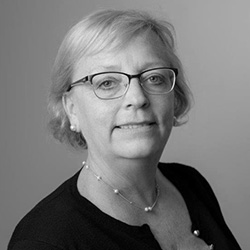News
Anid Joins Executive Roundtable on Future of Higher Ed
December 18, 2020
Pictured from left: Yvonne Romero da Silva, Ellen Moran, and Nada Anid.
On December 9, Vice President for Strategic Communications and External Affairs (SCEA) Nada Anid, Ph.D., joined Yvonne Romero da Silva, Ed.D., vice president for Enrollment at Rice University, and Ellen Moran, vice chancellor for Strategic Communications and Marketing at the University of Pittsburgh, for a virtual executive roundtable focused on the “Future of Higher Education.”
During the hourlong conversation, hosted by the digital marketing agency The Primacy, the trio of experts discussed how COVID-19 has fundamentally changed prospective students’ needs and expectations and how colleges and universities are finding new ways to meet students where they are. The three executives shared their vision of where enrollment, marketing, and communications are heading in the future.
Matt Cyr, managing director of education at Primacy, kicked off the discussion by sharing results of a recent survey his firm conducted with prospective undergraduate and graduate students as well as administrators with a focus on enrollment, cost and financial aid, online learning, and marketing and communications. Key themes that surfaced included that higher ed is in a “buyer’s market” mode, with students poised to take the best offers made to them, and that prospects are also looking closer to home or considering gap years or plan to defer their enrollment. And while the survey indicated increased financial need and noted under-budgeting, that did not translate to students being less selective about their college choices. The survey also pointed to the irrefutable fact that digital communications are more critical than ever and that investments in those areas are being made as universities understand that brand awareness and reputation are essential drivers for prospective students.
Anid shared New York Tech and SCEA’s plans following a challenging 2020: “We’re becoming more focused, more integrated, and smarter,” she said, “As an engineer, I’m grounded in data-informed decision making, and that is helping us in finding what gaps to fill. We want to continue to look at data analytics. We’re looking at SEO to optimize and make sure everything we’re doing is attracting the user…We’re seeing a paradigm shift in our emphasis on print materials and pivoting faster than ever in the digital realm.”
As part of the digital discussion, the panelists spoke about innovations in social media, video, personalization, and responsiveness to how Gen Z thinks and what they expect. “This is where our students are,” Anid pointed out as she shared activities such as student takeovers on institutional social media channels and student-led interview videos. “We know prospective students want and need that authenticity.” The group also discussed the “virtualization” of many aspects of the university experience and creative approaches in that realm.
In addressing financial concerns that arose in the Primacy survey, Anid noted New York Tech’s mission of “offering access to opportunity” and generous financial aid, particularly given the large percentage of Pell-eligible students. “But there are limits,” she said. “Private and public institutions alike should come together and advocate for debt forgiveness, 0% loans, and push financial literacy agenda at the high school level.”
In response to a question raised by an attendee regarding spurring innovation, Anid mentioned the university’s current efforts in “convening a series of stakeholders to see how higher education can contribute to the growth of our local economy to help the millions of unemployed. At New York Tech, we’re thinking of traditional and nontraditional students and how, as a higher ed institution, we can contribute to build the workforce of the future, including health and biotech.”
Watch the full executive roundtable discussion.





